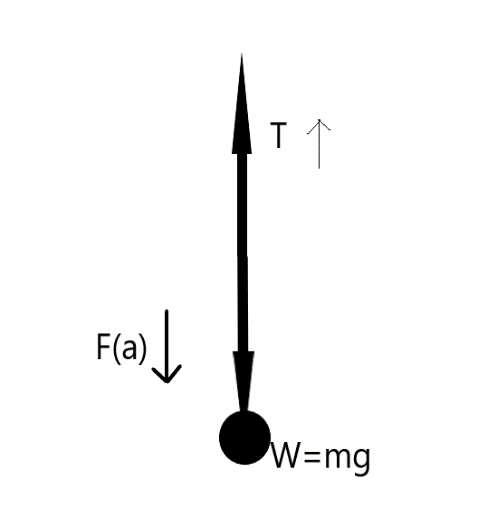
The body of mass $M$ tied to a string is lowered down at a constant acceleration of $\dfrac{g}{4}$ along a vertical distance $h$ then the work done by the string is
(A) $\dfrac{3}{4}Mgh$
(B) $\dfrac{1}{4}Mgh$
(C) $\dfrac{{ - 3}}{4}Mgh$
(D) $\dfrac{{ - 1}}{4}Mgh$
Answer
219k+ views
Hint: Work done is defined as the measure of energy transfer, occurring when a certain object moves over a distance when an external force is applied in the direction of displacement. In other words, work done is also defined as the product of tension and displacement.
Complete step by step solution
Let the acceleration of the gravity be $g$ and tension be $T$.
Consider all the forces acting on a string in the following figure:

Weight of the body, that is, $mg$ in the downward direction, tension is in the upward direction and accelerating force applies in the downward direction.
1. Tension force is the pulling force which is transmitted axially through the string, cable, etc.
2. Weight is measured with reference to the gravity of the earth, thus it always applies in the downward direction of the object.
3. Accelerating force is a force that causes accelerated motion. It is defined as the product of mass and acceleration.
Now balance all the force acting on it,
$ \Rightarrow W - T = F\left( a \right)$
Substitute the value of $W$and $F\left( a \right)$.
$ \Rightarrow mg - T = ma$
Substitute the value of constant acceleration.
$ \Rightarrow mg - T = \dfrac{{mg}}{4}$
1. Take the same coefficient to one side of the equation.
2. Write the tension in terms of mass and acceleration due to gravity, take LCM of the denominator to determine the value.
$ \Rightarrow T = mg - \dfrac{{mg}}{4} = \dfrac{3}{4}mg$
Work done by tension in the string when the object is lowered down at a distance $h$ is,
$ \Rightarrow W = T \cdot h$
$ = Th\cos {180^ \circ }$
$ = - T \cdot h$
Substitute the value of tension in the above equation.
$ \Rightarrow W = - \dfrac{3}{4}Mg \cdot h$
$ = - \dfrac{3}{4}Mgh$
So, option (3) is the correct answer.
Note:
The work done is defined as a product of tension and displacement. While calculating the displacement, must remember that whether it is opposite to the tension force or in the direction. For balancing of force acting on a body direction is necessary.
Complete step by step solution
Let the acceleration of the gravity be $g$ and tension be $T$.
Consider all the forces acting on a string in the following figure:

Weight of the body, that is, $mg$ in the downward direction, tension is in the upward direction and accelerating force applies in the downward direction.
1. Tension force is the pulling force which is transmitted axially through the string, cable, etc.
2. Weight is measured with reference to the gravity of the earth, thus it always applies in the downward direction of the object.
3. Accelerating force is a force that causes accelerated motion. It is defined as the product of mass and acceleration.
Now balance all the force acting on it,
$ \Rightarrow W - T = F\left( a \right)$
Substitute the value of $W$and $F\left( a \right)$.
$ \Rightarrow mg - T = ma$
Substitute the value of constant acceleration.
$ \Rightarrow mg - T = \dfrac{{mg}}{4}$
1. Take the same coefficient to one side of the equation.
2. Write the tension in terms of mass and acceleration due to gravity, take LCM of the denominator to determine the value.
$ \Rightarrow T = mg - \dfrac{{mg}}{4} = \dfrac{3}{4}mg$
Work done by tension in the string when the object is lowered down at a distance $h$ is,
$ \Rightarrow W = T \cdot h$
$ = Th\cos {180^ \circ }$
$ = - T \cdot h$
Substitute the value of tension in the above equation.
$ \Rightarrow W = - \dfrac{3}{4}Mg \cdot h$
$ = - \dfrac{3}{4}Mgh$
So, option (3) is the correct answer.
Note:
The work done is defined as a product of tension and displacement. While calculating the displacement, must remember that whether it is opposite to the tension force or in the direction. For balancing of force acting on a body direction is necessary.
Recently Updated Pages
Two discs which are rotating about their respective class 11 physics JEE_Main

A ladder rests against a frictionless vertical wall class 11 physics JEE_Main

Two simple pendulums of lengths 1 m and 16 m respectively class 11 physics JEE_Main

The slopes of isothermal and adiabatic curves are related class 11 physics JEE_Main

A trolly falling freely on an inclined plane as shown class 11 physics JEE_Main

The masses M1 and M2M2 M1 are released from rest Using class 11 physics JEE_Main

Trending doubts
JEE Main 2026: Application Form Open, Exam Dates, Syllabus, Eligibility & Question Papers

Understanding Uniform Acceleration in Physics

Derivation of Equation of Trajectory Explained for Students

Hybridisation in Chemistry – Concept, Types & Applications

Understanding the Angle of Deviation in a Prism

Understanding Collisions: Types and Examples for Students

Other Pages
JEE Advanced Marks vs Ranks 2025: Understanding Category-wise Qualifying Marks and Previous Year Cut-offs

Units And Measurements Class 11 Physics Chapter 1 CBSE Notes - 2025-26

NCERT Solutions For Class 11 Physics Chapter 8 Mechanical Properties Of Solids

Motion in a Straight Line Class 11 Physics Chapter 2 CBSE Notes - 2025-26

NCERT Solutions for Class 11 Physics Chapter 7 Gravitation 2025-26

Understanding Atomic Structure for Beginners




